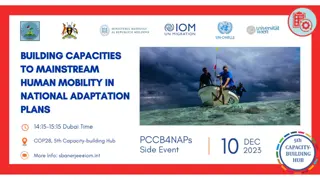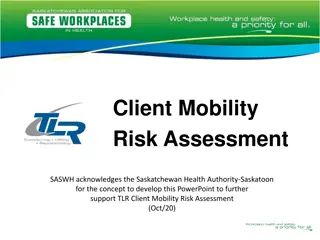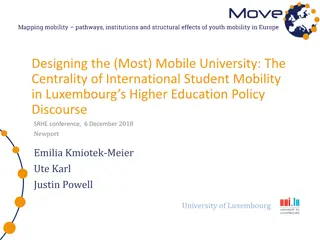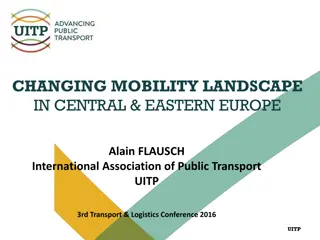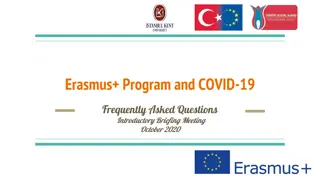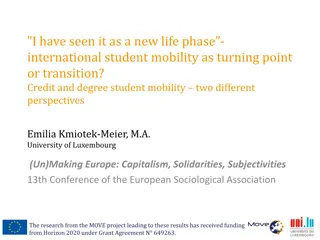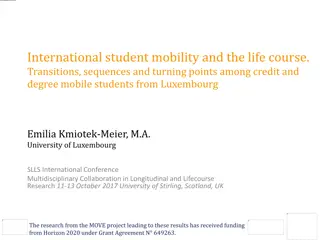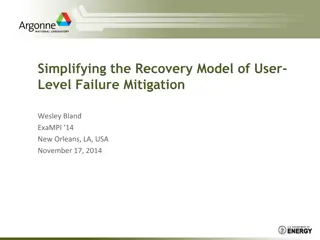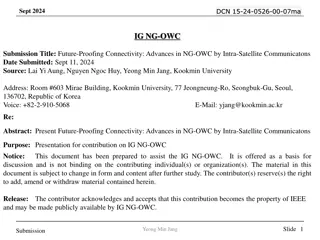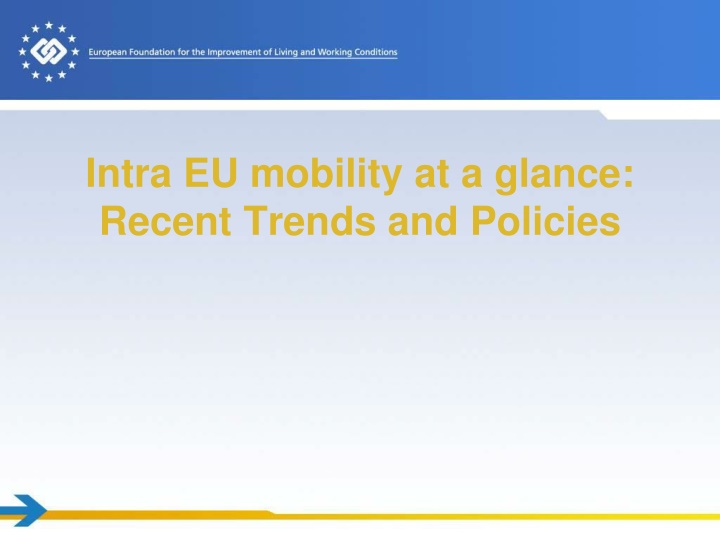
Recent Trends and Policies in EU Labour Mobility
Explore recent trends and policies in intra-EU labour mobility based on key findings from the Eurofound report. Discover changing patterns in employment by nationality, scale of intra-EU labour mobility, general mobility inflow rates, and international comparisons of labour mobility. Despite some limitations, the data sheds light on the status of labour mobility within the EU.
Uploaded on | 1 Views
Download Presentation

Please find below an Image/Link to download the presentation.
The content on the website is provided AS IS for your information and personal use only. It may not be sold, licensed, or shared on other websites without obtaining consent from the author. If you encounter any issues during the download, it is possible that the publisher has removed the file from their server.
You are allowed to download the files provided on this website for personal or commercial use, subject to the condition that they are used lawfully. All files are the property of their respective owners.
The content on the website is provided AS IS for your information and personal use only. It may not be sold, licensed, or shared on other websites without obtaining consent from the author.
E N D
Presentation Transcript
Intra EU mobility at a glance: Recent Trends and Policies
Speaker notes Key findings from Eurofound report Labour mobility in the EU: Recent trends and policies (2014), drawing from national reports (28 EU countries) and desk research
Changing patterns in labour mobility in the EU Change in employment by nationality, 2008 2012, EU27 (thousands) Change 08-12 2008 2009 2010 2011 2012 EU27 migrant workers Non-EU migrant workers Native born workers 5,771.5 5,870.8 6,073.0 6,405.2 6,599.0 14.3 8,854.6 8,574.0 8,559.5 8,684.7 8,582.3 -3.1 206,535.0 202,930.8 201,679.5 201,851.1 200,799.0 -2.8 Source: EU-LFS, 2008 2012
Scale of intra-EU labour mobility EU nationals working in another Member State as a percentage of total employment, 2008 2012 16 14 12 10 8 6 4 2 0 2008 2012 Source: EU-LFS, 2008 2012
General mobility: inflow rates per 1000 (2008 and 2012) in selected EU Member States 30 25 20 15 EU nationals Total 10 5 0 2008 2012 2008 2012 2008 2012 2008 2012 2008 2012 2008 2012 2008 2012 DE DK ES IT IE NL UK Sources: Eurofound based on national data (Statistisches Bundesamt, Destatis; Danmarks Statistik; Instituto Nacional de Estadistica, INE; Istituto Nazionale di Statistica, Istat; Central Statistics Office, CSO; Centraal Bureau voor de Statistiek, CBS; long-term international migration data from the International Passenger Survey, IPS. Note: EU nationals figure excludes returning nationals.
Labour mobility still low in international comparison Annual cross-border and within-region mobility as a percentage of total population, 2010 US: between 50 states 2.4 Australia: between 8 states/territories 1.5 US: between 4 main regions 1.24 Canada: between 10 provinces/territories 0.98 EU15: between NUTS-1 regions within countries 0.95 Canada: between Quebec and 9 other provinces/territories 0.39 EU27: between 27 countries 0.29 0 Source: OECD, 2012 0.5 1 1.5 2 2.5 3
Interregional mobility in the EU also limited Although the data available are not always strictly comparable, the annual rate for interregional mobility is approximately 1% at NUTS 1 level Interregional mobility rates appear to be higher in countries with a high GDP level and lower in some of the poorer eastern European countries as well as countries that were severely affected by the crisis, such as Italy and Portugal
Language hurdles: main barrier to intra-EU mobility Practical difficulties encountered or expected in relation to working abroad (% of respondents) Other 2% Access to childcare, school or university for your children 4% Problems with income taxes or similar 4% Problems to return home and integrate inot professional or private life 6% having my pension rights transferred 9% Having my educational and professional qualifications recognised 10% Finding a job for my partner / spouse 10% Obtaining a work permit 10% Accessing health care and other social benefits 11% Dealing with the necessary adinistrative formalities 13% Adapting to a different culture 16% Finding a suitable housing 16% Finding a job 24% Lack of language skills 52% 0% 10% 20% 30% 40% 50% 60% Source: Eurobarometer, 337/ Wave 72.5
Limited availability of publicly- funded foreign language courses Access to publicly-funded foreign language courses (for natives) or education in the host-nation language (for EU mobile citizens) has the potential of reducing the persistent language barrier Only 14 EU Member States (CZ, DK, EE, DE, IT, LV, LT, LU, MT, PT, RO, SK, SE) offer publicly funded language courses to EU mobile citizens In a few EU Member States (HR, EE, FR, LV, LU, PL and SI) national public employment services offer language courses to their citizens prior to departure to another country
Availability of information about job opportunities in EU countries Main source of help received by working EU migrants in the host country to find current job or set up a business 100% 90% 80% 70% 60% 50% 40% 30% 20% 10% 0% GR CY PT IE FR LU LT NL UK AT ES BE SE EU15 Relatives/friends Private employment services Other Source: 2008 ad-hoc module of the EU-LFS Notes: Data available only for selected EU countries; data refers to migrants aged 15 74 yrs. Public employment services Migrant or ethnic organisation None
Support to cross-border matching of jobseekers and vacancies Evidence that EURES through the national public employment agencies is increasingly becoming a key provider of information on job vacancies Public employment services in some Member States (FR, LV, LT and SE) have established additional job search databases to promote international vacancies With support of ESF and in cooperation with EURES, special agreements were signed by the German government with other EU Member States (HR, DK, FR, IT, PT and ES) to attract young EU workers to Germany Cooperation between national employment agencies and information-sharing resources is still limited and needs to be further enhanced.
Improving cross-border portability of unemployment benefits Extension of export period of unemployment benefits 3 months without prolongation 3 months with possibility of prolongation 6 months by default CY, DK, FI, FR, HU, HR, IT, IE, NL, NO, SE, UK AT, BE, BG, EE, EL, ES, DE, LU, LT, LV, MT, PL, PT, RO, SI, SK CZ Source: Eurofound, based on national reports; European Commission, 2011
Measures facilitating geographical mobility within ALMPs Most EU countries only prescribe that the unemployed person should be willing to take up a job within a reasonable commuting distance of their home. In Norway and Sweden, unemployed people are required to be willing not just to commute but to move to another region within the country if a suitable job is available there. In Sweden, the public employment service provides support for relocation expenses, support for travelling costs for job interviews, and compensation for travel costs and accommodation for participants in labour market programmes. The support is provided both for interregional and cross-border labour mobility.
Other financial incentives for labour mobility Incentives often linked to regional policies preventing outflow of skilled labour from peripheral regions E.g. In Croatia, rent is almost free to teachers and healthcare professionals (only country nationals) taking up jobs in remote areas such as islands or mountainous regions, where there is high turnover and acute labour shortages in teaching and healthcare. However, the main driver of other policy initiatives is social inclusion E.g. Italy, where the municipality of Parma has built public housing for both Italian and foreign mobile workers. The rent is commensurate with the income of the occupier, who can live there until they find permanent accommodation.



